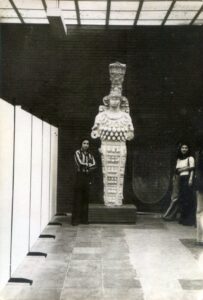© Copyright photo by Levent Ağaoğlu
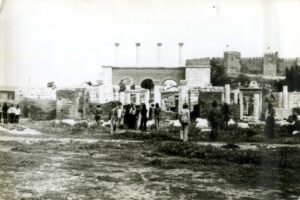
On the hill, the protective bastions of the castle hang on the plain, the carrier arch and columns of the antique. Curious eyes of tourists. The Seljuk empire arrived at the Aegean coast and gave its name to a town and castle. Like its shores, the Aegean has a rich and intricate past, layer upon layer. The wealth of a collective civilization. Underneath is Ephesus and on the ground is Selcuk. The union of eagles. Selcuk Basilica April 1975 Izmir Trip
Tepede kalenin koruyucu burçları düzlükte asarı antikanın taşıyıcı kemer ve sütunları. Turistlerin meraklı bakışları. Selçuklu imparatorluğu, Ege kıyılarına kadar gelmiş adını bir ilçeye ve kaleye vermiş. Kıyıları gibi girintili çıkıntılı zengin bir geçmişi var Ege’nin, kat kat üstüne. Ortaklaşa bir medeniyetin zenginliği. Altı Efes üstü Selçuk. Kartalların birlikteliği. Selçuk Bazilika Nisan 1975. İzmir Gezisi
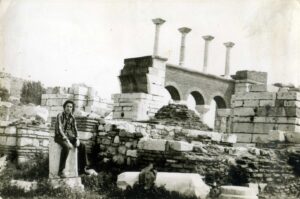
Selcuk Castle Behind. Basilica. Time-defying stones and marbles. Arches between columns. Broken marble pillars on the ground. Remnants of a masterpiece. Blackened white stones. Selçuk Basilica, April 1975
Arkada Selçuk Kalesi. Bazilika. Zamana meydan okuyan taşlar, mermerler. Sütunlar arası kemerler. Yerlerde kırık mermer sütunlar. Bir şaheserden geride kalanlar. Kararmış beyaz taşlar. Selçuk Bazilika Nisan 1975
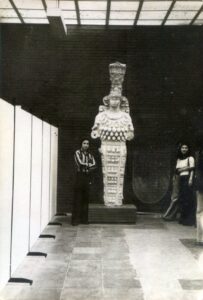
With Artemis, Goddess of Fertility. In Selcuk museum. How come it was not stolen, it remained in her own ground. The fertility of the geography since the goddess Cybele, the deep beliefs of its people. Isn’t it much more meaningful than the New York Liberty statue? In the poet’s language, the land where “Mother Eve is yesterday’s child” is not with adjective New, but the oldest. Minds that contemplate the statue, hands that carve it; always Turkey geography. Ephesus Museum Artemis April 1975
Bereket Tanrıçası Artemis ile. Selçuk müzesinde. Nasıl oldu da götürülmemiş, yerinde kalmış. Tanrıça Kibele’den buyana coğrafyanın bereketi, insanlarının derin inançları. New York Hürriyet heykelinden çok daha anlamlı değil mi. Şairin dilinden “Havva Ana’nın dünkü çocuk” sayıldığı topraklar New (Yeni) değil, en eskidir. Heykeli düşünen zihinler, yontan bezeyen eller; hep Türkiye coğrafyası. Efes Müzesi. Artemis Nisan 1975
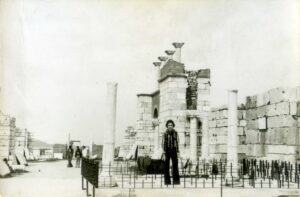
Considered one of the most important figures of Christianity, St. John (St. Jean) is one of the 12 apostles of Jesus Christ. Also known as St. John’s, St. The basilica built on the tomb of John is one of the most important witnesses of the early Christian period. A 17-year-old Turkish teenager watches the future in front of the ruins of a 2000-year-old church. The rich treasures of the past will also illuminate the future. Selcuk Basilica Izmir April 1975
Hristiyanlığın en önemli figürlerinden biri sayılan St. John (St. Jean) Hz.İsa’nın 12 havarisinden biri. Aziz Yahya olarak da bilinen St. John’un mezarı üstüne inşa esilen bazilika ise erken hristiyanlık döneminin en önemli tanıklarından. 2000 yıllık bir kilisenin kalıntıları önünde 17 yaşında bir Türk genci ufuklardaki geleceği gözlüyor. Geçmişin zengin hazineleri geleceğini de aydınlatacak. Selçuk Bazilika İzmir Nisan 1975

